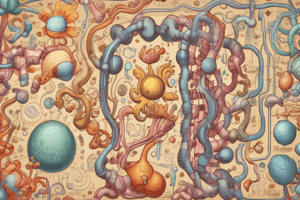Podcast
Questions and Answers
What is the primary location of fatty acid synthesis?
What is the primary location of fatty acid synthesis?
- Cytosol
- Adipose tissue and liver (correct)
- Erythrocytes
- Mitochondria
What is the source of acetyl CoA in fatty acid synthesis?
What is the source of acetyl CoA in fatty acid synthesis?
- Oxidation of fatty acids
- Oxidation of pyruvate
- Degradation of ketone bodies
- All of the above (correct)
Why is the coenzyme A portion of acetyl CoA not transported to the cytosol?
Why is the coenzyme A portion of acetyl CoA not transported to the cytosol?
- Because it is too large to cross the mitochondrial membrane
- Because it cannot cross the mitochondrial membrane (correct)
- Because it is not soluble in water
- Because it is negatively charged
What is the purpose of citrate synthase in fatty acid synthesis?
What is the purpose of citrate synthase in fatty acid synthesis?
Why can't the brain and erythrocytes use fatty acids as a source of fuel?
Why can't the brain and erythrocytes use fatty acids as a source of fuel?
What is the energy source for the carbon-carbon condensations in fatty acid synthesis?
What is the energy source for the carbon-carbon condensations in fatty acid synthesis?
What is the rate-limiting and regulated step in fatty acid synthesis?
What is the rate-limiting and regulated step in fatty acid synthesis?
What is required for the carboxylation of acetyl CoA to form malonyl CoA?
What is required for the carboxylation of acetyl CoA to form malonyl CoA?
What is the effect of citrate on acetyl CoA carboxylase?
What is the effect of citrate on acetyl CoA carboxylase?
What is the role of malonyl-CoA in regulating acetyl CoA carboxylase?
What is the role of malonyl-CoA in regulating acetyl CoA carboxylase?
What is the effect of epinephrine on acetyl CoA carboxylase?
What is the effect of epinephrine on acetyl CoA carboxylase?
What is the result of a prolonged consumption of a high-calorie, high-carbohydrate diet on acetyl CoA carboxylase synthesis?
What is the result of a prolonged consumption of a high-calorie, high-carbohydrate diet on acetyl CoA carboxylase synthesis?
What is the enzyme responsible for the elongation of the fatty acid chain in 2-carbon increments?
What is the enzyme responsible for the elongation of the fatty acid chain in 2-carbon increments?
What is the function of acyl carrier protein (ACP) in fatty acid synthase?
What is the function of acyl carrier protein (ACP) in fatty acid synthase?
What is the product of the carboxylation of acetyl CoA?
What is the product of the carboxylation of acetyl CoA?
What is the subcellular location of the first step of fatty acid biosynthesis?
What is the subcellular location of the first step of fatty acid biosynthesis?
Flashcards are hidden until you start studying
Study Notes
Fatty Acid Synthesis (Lipogenesis)
- Excess carbohydrates and proteins can be converted to fatty acids and stored as triglycerols.
- Fatty acid synthesis occurs primarily in the liver and adipose tissue.
Stage 1: Mitochondria
- Acetyl CoA is produced from:
- Oxidation of pyruvate
- Degradation of fatty acids
- Degradation of ketone bodies
- Acetyl CoA is transferred from the mitochondrial matrix to the cytosol in the form of citrate.
Stage 2: Cytosol
- Citrate is cleaved by ATP-citrate lyase to produce cytosolic acetyl CoA and oxaloacetate.
- Carboxylation of acetyl CoA to form malonyl CoA requires:
- Acetyl CoA carboxylase
- Biotin
- ATP
- Bicarbonate (HCO3-)
- Acetyl CoA carboxylase is a multienzyme protein consisting of 3 identical functional subunits.
Regulation of Acetyl CoA Carboxylase
- Short-term regulation:
- Citrate: allosteric activation
- Palmitoyl-CoA: allosteric inactivation (feedback inhibition)
- Malonyl-CoA: allosteric inactivation
- Reversible phosphorylation: regulated by cAMP-dependent protein kinase
- Long-term regulation:
- High-calorie, high-carbohydrate diets: increase acetyl CoA carboxylase synthesis and fatty acid synthesis
- Low-calorie diet or fasting state: decrease acetyl CoA carboxylase synthesis and fatty acid synthesis
Fatty Acid Synthesis (Continued)
- Step 3: Elongation of the fatty acid chain (in 2-carbon increments) by fatty acid synthase.
- Fatty acid synthase (FAS):
- Dimeric enzyme
- Each monomer composed of:
- 7 different enzymatic activities
- Acyl carrier protein (ACP): covalently binds to pantothenic acid, carrying acetyl and acyl units on its terminal thiol (-SH) group.
Studying That Suits You
Use AI to generate personalized quizzes and flashcards to suit your learning preferences.




